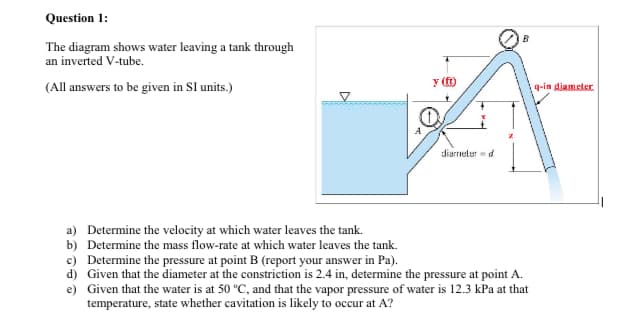Question 1: The diagram shows water leaving a tank through an inverted V-tube. y (D (All answers to be given in SI units.) q-in diameter diarrneler -d a) Determine the velocity at which water leaves the tank. b) Determine the mass flow-rate at which water leaves the tank. c) Determine the pressure at point B (report your answer in Pa). d) Given that the diameter at the constriction is 2.4 in, determine the pressure at point A. e) Given that the water is at 50 °C, and that the vapor pressure of water is 12.3 kPa at that temperature, state whether cavitation is likely to occur at A?
Question 1: The diagram shows water leaving a tank through an inverted V-tube. y (D (All answers to be given in SI units.) q-in diameter diarrneler -d a) Determine the velocity at which water leaves the tank. b) Determine the mass flow-rate at which water leaves the tank. c) Determine the pressure at point B (report your answer in Pa). d) Given that the diameter at the constriction is 2.4 in, determine the pressure at point A. e) Given that the water is at 50 °C, and that the vapor pressure of water is 12.3 kPa at that temperature, state whether cavitation is likely to occur at A?
Principles of Heat Transfer (Activate Learning with these NEW titles from Engineering!)
8th Edition
ISBN:9781305387102
Author:Kreith, Frank; Manglik, Raj M.
Publisher:Kreith, Frank; Manglik, Raj M.
Chapter5: Analysis Of Convection Heat Transfer
Section: Chapter Questions
Problem 5.4P: 5.4 Evaluate the Stanton number for flow over a tube from the following data:
, , , , .
Related questions
Question
x= 7 y=8 z=16 9=2.8

Transcribed Image Text:Question 1:
B
The diagram shows water leaving a tank through
an inverted V-tube.
y ()
(All answers to be given in SI units.)
q-in diameter.
diarnelerd
a) Determine the velocity at which water leaves the tank.
b) Determine the mass flow-rate at which water leaves the tank.
c) Determine the pressure at point B (report your answer in Pa).
d) Given that the diameter at the constriction is 2.4 in, determine the pressure at point A.
e) Given that the water is at 50 °C, and that the vapor pressure of water is 12.3 kPa at that
temperature, state whether cavitation is likely to occur at A?
Expert Solution
This question has been solved!
Explore an expertly crafted, step-by-step solution for a thorough understanding of key concepts.
Step by step
Solved in 2 steps with 2 images

Knowledge Booster
Learn more about
Need a deep-dive on the concept behind this application? Look no further. Learn more about this topic, mechanical-engineering and related others by exploring similar questions and additional content below.Recommended textbooks for you

Principles of Heat Transfer (Activate Learning wi…
Mechanical Engineering
ISBN:
9781305387102
Author:
Kreith, Frank; Manglik, Raj M.
Publisher:
Cengage Learning

Principles of Heat Transfer (Activate Learning wi…
Mechanical Engineering
ISBN:
9781305387102
Author:
Kreith, Frank; Manglik, Raj M.
Publisher:
Cengage Learning